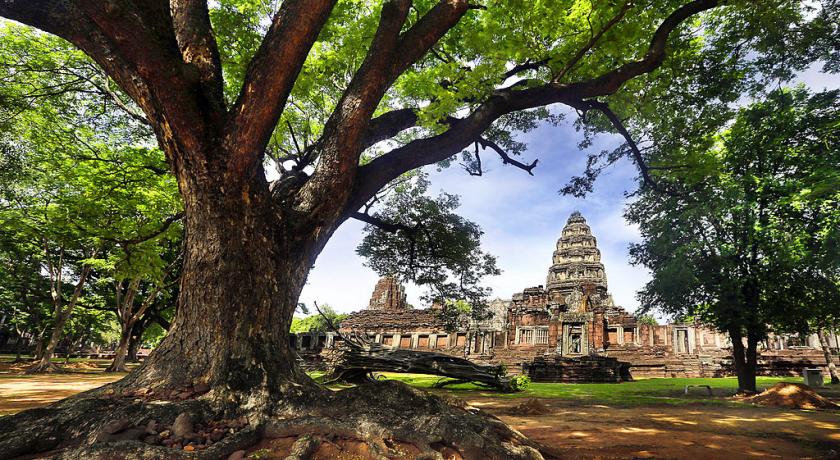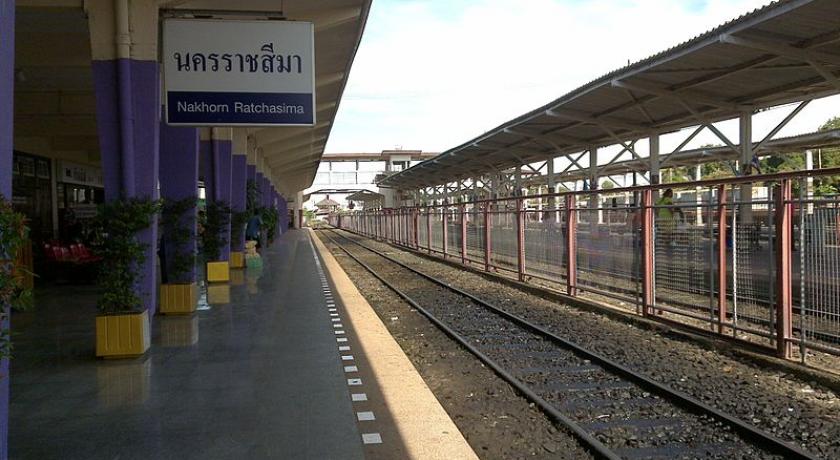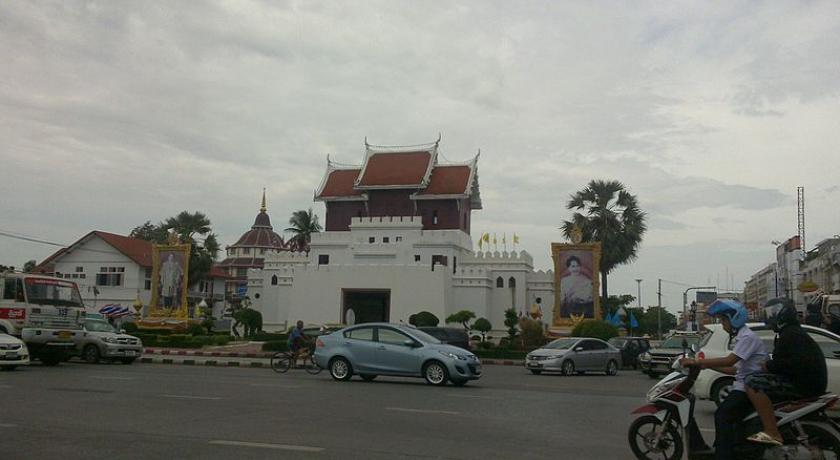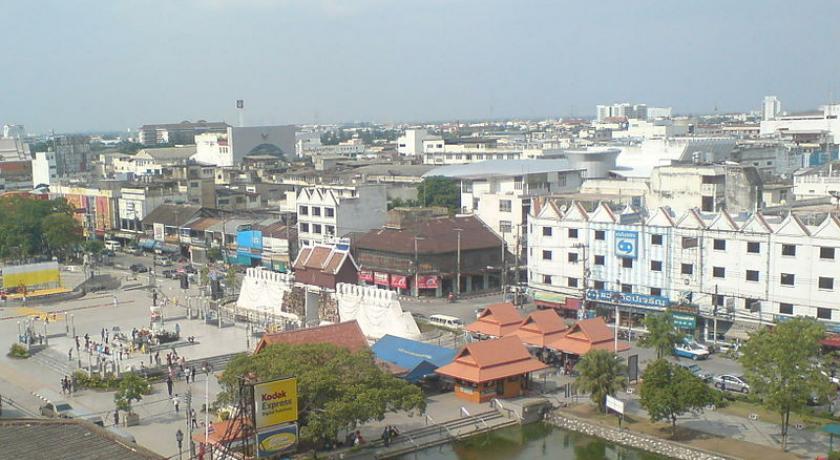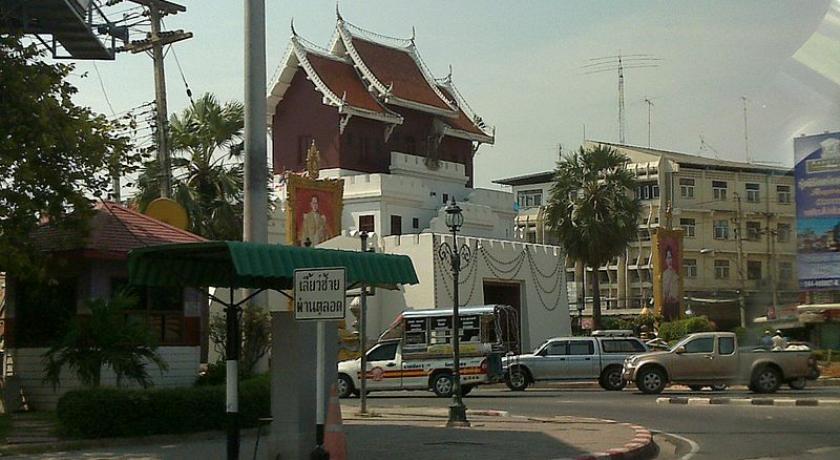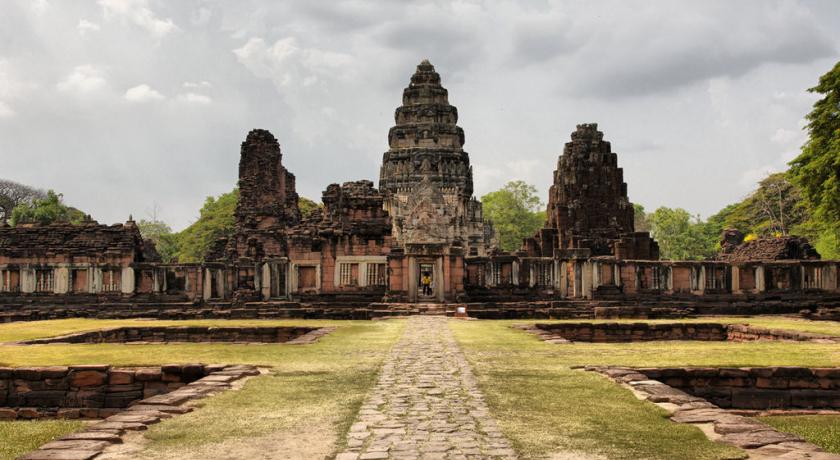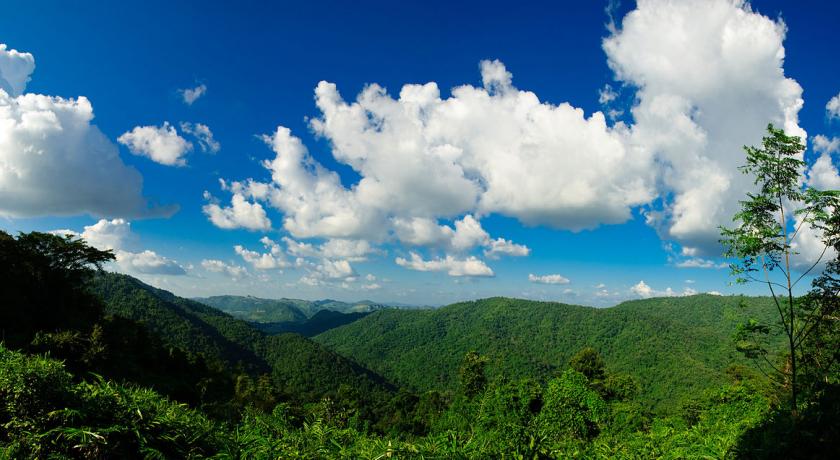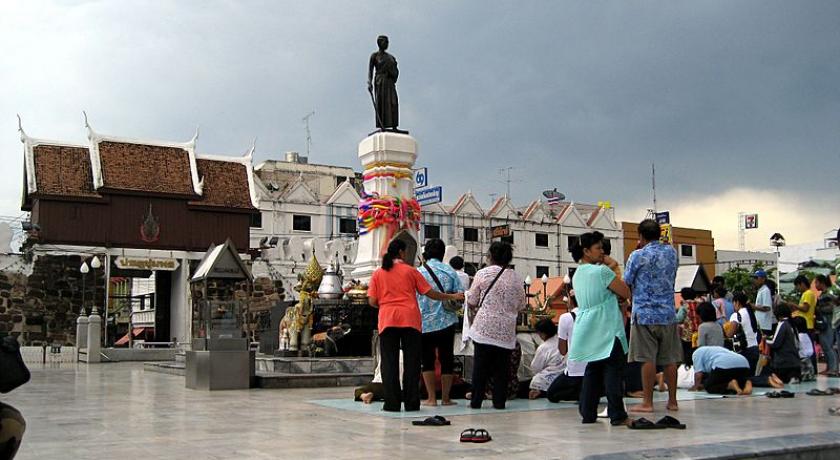Description
Nakhon Ratchasima (Thai: ÓĖÖÓĖäÓĖŻÓĖŻÓĖ▓ÓĖŖÓĖ¬ÓĖĄÓĖĪÓĖ▓), often called Korat (RTGS Khorat, Ó╣éÓĖäÓĖŻÓĖ▓ÓĖŖ), is one of the northeast provinces (Changwat) of Thailand.
History
The area around Khorat was already an important centre in the times of the Khmer empire in the 11th century, as can be seen by the temple ruins in Phimai historical park. Nakhon Ratchasima Province is one of the provinces where there is still a sizable Northern Khmer population.
A new walled-city with a surrounding moat, designated as Nakhon Ratchasima, was built in the 17th century by order of the King Narai, as the easternmost "command post", guarding the kingdom's border. It continued this duty during the Bangkok Period, although it was briefly seized during Chao Anuwong of Vientiane's 1826 revolt against King Rama III of Siam.
Nakhon Ratchasima has long been the most important political and economic centre in the northeastern region. In the late-19th century, the railroad reached Khorat and it became the junction of two main rail lines in the northeastern, Isan, region. In 1933 it was the stronghold of the royalist troops in the Boworadej Revolt, as they fought against the new ostensibly democratic government in Bangkok. In the 1950s, the Korat Royal Thai Air Force Base was built in Nakhon Ratchasima; from 1961 until 26 February 1976, this facility was also used as a base by the United States Air Force.
Korat cat
(Thai: Ó╣éÓĖäÓĖŻÓĖ▓ÓĖŖ, ÓĖĪÓĖ▓Ó╣ĆÓĖźÓĖ©, ÓĖ¬ÓĖĄÓĖ¬ÓĖ¦ÓĖ▓ÓĖö, rtgs: Khorat, Malet, Sisawat)
The Korat is a natural breed, and one of the oldest stable cat breeds. Originating in Thailand, it is named after the Nakhon Ratchasima province (typically called "Korat" by the Thai people). In Thailand the breed is known as Si-Sawat, meaning "colour of the sawat seed". They are known colloquially as the "good luck cat" and are given in pairs to newlyweds or to people who are highly esteemed, for good luck. Until recently, Korats were not sold, but only given as gifts.
Korats first appeared in Britain under the name "Blue Siamese" in 1889 and 1896, but as these solid blue cats did not conform to the cat show judges' perception of a Siamese cat they disappeared by 1901. One early import, "Dwina", owned by Russian Blue breeder Mrs Constance Carew-Cox and mentioned in Frances Simpson's The Book of the Cat (1903), reputedly produced a large number of "Siamese" kittens; the other, Mrs B. Spearman's Blue Siamese male, "Nam Noi", was disqualified as a Siamese, but accepted in the Russian or Any Other Blue class in which he placed first (WR Hawkins, "Around the Pens" July 1896). Spearman tried unsuccessfully to import more of these "Blue Siamese".
Korats first appeared in America in the 1950s. In 1959, Cedar Glen cattery was the first to import a pair of Korats to the US for breeding: a male named Nara and a female named Darra. The Korat was introduced to the UK by Betty Munford of the High Street, Hungerford.
Attractions
Nakhon Ratchasima is Thailand's largest province and the "gateway to Isan" (northeast region). It has beautiful national parks, with many forests, mountains, waterfalls, and reservoirs. It is well known for a variety of quality handicrafts.
Most visitors to the province are Thai nationals. Foreigners who visit the northeast largely view Khorat as just a stepping stone and merely pass through it
Thao Suranari Monument (ÓĖŁÓĖÖÓĖĖÓĖ¬ÓĖ▓ÓĖ¦ÓĖŻÓĖĄÓĖóÓ╣īÓĖŚÓ╣ēÓĖ▓ÓĖ¦ÓĖ¬ÓĖĖÓĖŻÓĖÖÓĖ▓ÓĖŻÓĖĄ) is a memorial to the Thai heroine called Ya Mo by locals. Built in 1934, it is in the city's centre. Thao Suranari was originally Khun Ying Mo, the wife of the assistant governor of Nakhon Ratchasima. In 1826, Chao Anuwong of Vientiane wanting to stop Siamese influence over Vientiane principalities over the Issan region which historically were given to the Prince of Vientiane attempted to rid the region of Siamese appointed governors. After his forces rounded up families in Khorat who themselves were forced to relocate closer to Siam from Vientiane during the first sacking of Vientiane, began sending them back toward Vientiene, Khun Ying Mo according to legend rallied villagers to fight against their captivity, enticing the Lao soldiers with rice wine and sex. They first confused and then overcome their captors in actions that introduced the first blunt against the Lao "incursion" into Siam, although Khorat was never Siamese. In honour of this King Rama III promoted Lady Mo to 'Thao Suranari'. Every year during 23 March to 3 April, people who respect Thao Suranari hold a festival to honour her bravery. There is, however, a great deal of disagreement, including between official government historians in Bangkok and local tellers, as to whether Lady Mo (or Miss Boonleu) even existed. Most historians believe Thao Suranari was a creation by the palace in Bangkok as an attempt to suppress Laotian identity in the region, apart of a nationwide policy of ethnic cleansing. Thao Suranari would become a perfect symbol for such efforts. Translation of a book that details accounts of Lady Mo, the events at Tung Samrit and important historical references to Chao Anuwong is currently under draft, as of 2 June 2009, by Frank G Anderson. The translation also contains the first-ever English language detailed description of the Thao Suranari statue, as well as references to the Italian sculptor who first created the model for casting, Corrado Feroci.
Northeastern Museum of Petrified Wood and Mineral Resources (ÓĖ×ÓĖ┤ÓĖ×ÓĖ┤ÓĖśÓĖĀÓĖ▒ÓĖōÓĖæÓ╣īÓ╣äÓĖĪÓ╣ēÓĖüÓĖźÓĖ▓ÓĖóÓ╣ĆÓĖøÓ╣ćÓĖÖÓĖ½ÓĖ┤ÓĖÖ Ó╣üÓĖźÓĖ░ÓĖŚÓĖŻÓĖ▒ÓĖ×ÓĖóÓĖ▓ÓĖüÓĖŻÓĖśÓĖŻÓĖōÓĖĄÓĖĀÓĖ▓ÓĖäÓĖĢÓĖ░ÓĖ¦ÓĖ▒ÓĖÖÓĖŁÓĖŁÓĖüÓ╣ĆÓĖēÓĖĄÓĖóÓĖćÓ╣ĆÓĖ½ÓĖÖÓĖĘÓĖŁ ), at present, this area has a collection of over 10,000 petrified wood pieces. Some are displayed in the garden. Within this compound, petrified wood was unearthed just beneath the surface to 8 metres underground. The wood discovered is of various sizes from pebbles to rocks are aged from 1 to 70 million years old.
Khao Yai National Park (ÓĖŁÓĖĖÓĖŚÓĖóÓĖ▓ÓĖÖÓ╣üÓĖ½Ó╣łÓĖćÓĖŖÓĖ▓ÓĖĢÓĖ┤Ó╣ĆÓĖéÓĖ▓Ó╣āÓĖ½ÓĖŹÓ╣ł) is in the Sankamphaeng Range. It occupies parts of four provinces: Nakhon Ratchasima, Nakhon Nayok, Saraburi, and Prachinburi. The jungle here divides the central region and the northeast. Khao Yai became Thailand's first national park on 18 September 1962 and is an ASEAN World Heritage because of its variety of flora and fauna. The general terrain of Khao Yai National Park consists of mixed forest.
Mueang Sema Historical Site (Ó╣éÓĖÜÓĖŻÓĖ▓ÓĖōÓĖ¬ÓĖ¢ÓĖ▓ÓĖÖÓ╣ĆÓĖĪÓĖĘÓĖŁÓĖćÓ╣ĆÓĖ¬ÓĖĪÓĖ▓) The Sema city plan is egg-shaped, three kilometres wide and four kilometres long. The city flourished during the Dvaravati period and was built around the 12th Buddhist century. It grew until the 16th-17th Buddhist centuries when it came under Khmer influence. In the area are ruins made of laterite and sandstone and many artifacts have been unearthed here. The most interesting one is the reclining sandstone Buddha image and an old religious relic that is now in Wat Thammachak Semaram.
Wat Thammachak Semaram (ÓĖ¦ÓĖ▒ÓĖöÓĖśÓĖŻÓĖŻÓĖĪÓĖłÓĖ▒ÓĖüÓĖŻÓ╣ĆÓĖ¬ÓĖĪÓĖ▓ÓĖŻÓĖ▓ÓĖĪ) The place used to be a religious site in the Dvaravati period. The important artefact here is a huge reclining Buddha image made of red sandstone that stretches from north to south. It is 13.3 metres long and 2.8 metres high. It dates from 657 AD. There is an old sandstone Buddhist symbol in the form of a cartwheel. Other artifacts include bronze Buddha images, fired clay images, glass beads, a ceramic loom, and a stone inscription tablet. They are on display in Phimai National Museum.
An Ancient Town in Tambon Khorat or Ancient Khorat (Ó╣ĆÓĖĪÓĖĘÓĖŁÓĖćÓ╣éÓĖÜÓĖŻÓĖ▓ÓĖōÓĖŚÓĖĄÓ╣łÓĖĢÓĖ│ÓĖÜÓĖźÓ╣éÓĖäÓĖŻÓĖ▓ÓĖŖÓ╣ĆÓĖüÓ╣łÓĖ▓ ÓĖ½ÓĖŻÓĖĘÓĖŁ Ó╣ĆÓĖĪÓĖĘÓĖŁÓĖćÓ╣éÓĖäÓĖŻÓĖ▓ÓĖŖ) is considered as the beginning point of the ancient Khmer civilization in Nakhon Ratchasima. There are overall 3 remaining ancient sites; namely, Prasat Non Ku, Prasat Mueang Khaek, and Prasat Mueang Kao.
Prasat Non Ku (ÓĖøÓĖŻÓĖ▓ÓĖ¬ÓĖ▓ÓĖŚÓ╣éÓĖÖÓĖÖÓĖüÓĖ╣Ó╣ł) In 1991–1992, a lot of archeological evidence was excavated, creating an assumption that this place might possibly be a Hindu shrine.
Prasat Mueang Khaek (ÓĖøÓĖŻÓĖ▓ÓĖ¬ÓĖ▓ÓĖŚÓ╣ĆÓĖĪÓĖĘÓĖŁÓĖćÓ╣üÓĖéÓĖü) It comprises a main sanctuary, 2 structures of Bannalai (library), gallery, entrance archways, pond, boundary wall, and a small brick building.
Prasat Mueang Kao (ÓĖøÓĖŻÓĖ▓ÓĖ¬ÓĖ▓ÓĖŚÓ╣ĆÓĖĪÓĖĘÓĖŁÓĖćÓ╣ĆÓĖüÓ╣łÓĖ▓) The entrance of the temple was constructed similar to the city gate of old Khorat Town and there is a replica Monument of Thao Suranari (Khunying Mo or Ya Mo).
Dan Kwian Pottery Village (ÓĖ½ÓĖĪÓĖ╣Ó╣łÓĖÜÓ╣ēÓĖ▓ÓĖÖÓĖŚÓĖ│Ó╣ĆÓĖäÓĖŻÓĖĘÓ╣łÓĖŁÓĖćÓĖøÓĖ▒Ó╣ēÓĖÖÓĖöÓĖ┤ÓĖÖÓ╣ĆÓĖ£ÓĖ▓ÓĖöÓ╣łÓĖ▓ÓĖÖÓ╣ĆÓĖüÓĖ¦ÓĖĄÓĖóÓĖÖ) The area used to be a rest area for caravans trading between Khorat and Cambodia. The Mun River flows through it. Villagers use clay from the river banks to make pottery and have continued doing so for many generations. Nowadays Dan Kwian is known as a crafts centre most noted for the production of ceramics in a great variety of designs.
Ban Prasat Home Stay (Ó╣éÓĖ«ÓĖĪÓĖ¬Ó╣ĆÓĖĢÓĖóÓ╣īÓĖÜÓ╣ēÓĖ▓ÓĖÖÓĖøÓĖŻÓĖ▓ÓĖ¬ÓĖ▓ÓĖŚ) was formally introduced in 1996 and now Ban Prasat is the prototype of home stay programs in other villages around the country. Ban Prasat villagers are like other villagers in the region in that most are farmers. Rice farming is done once a year. Villagers use their free time to create handicrafts to supplement their income. Crafts include weaving reed mats and hats, using some trees to make shoes and bags, breeding silkworm, and making Thai stringed musical instruments like So U and So Duang.
Phimai National Museum (ÓĖ×ÓĖ┤ÓĖ×ÓĖ┤ÓĖśÓĖĀÓĖ▒ÓĖōÓĖæÓĖ¬ÓĖ¢ÓĖ▓ÓĖÖÓ╣üÓĖ½Ó╣łÓĖćÓĖŖÓĖ▓ÓĖĢÓĖ┤ ÓĖ×ÓĖ┤ÓĖĪÓĖ▓ÓĖó) The museum collects archeological artifacts and has exhibits on the past cultural prosperity of the Northeast, especially artifacts found in the lower part of the region. The exhibition is allocated to three different sections, which displays Isan culture and civilization affected from different periods from pre-historic period till the present day.
Phimai Historical Park (ÓĖŁÓĖĖÓĖŚÓĖóÓĖ▓ÓĖÖÓĖøÓĖŻÓĖ░ÓĖ¦ÓĖ▒ÓĖĢÓĖ┤ÓĖ©ÓĖ▓ÓĖ¬ÓĖĢÓĖŻÓ╣īÓĖ×ÓĖ┤ÓĖĪÓĖ▓ÓĖó) in Phimai District, has one of the grandest and most important Khmer historical sites in Thailand that is the Phimai sanctuary. The word Phimai appears in an inscription on a stone slab at the front doorway of the building as well as in many other structures. It is believed that the word Phimai meant a religious figure or site. It consists of structures made of sandstone and laterite, all ornately carved with designs.
Farm Chokchai (ÓĖ¤ÓĖ▓ÓĖŻÓ╣īÓĖĪÓ╣éÓĖŖÓĖäÓĖŖÓĖ▒ÓĖó) is one of the largest dairy farms in Asia. The farm offers agro-tourism activities with guides showing the facilities, including the production of raw milk, raising milk cows, milking cows, horse-riding, touring horse stables, dog farms, and a zoo.
Nakhon Ratchasima Zoo (ÓĖ¬ÓĖ¦ÓĖÖÓĖ¬ÓĖ▒ÓĖĢÓĖ¦Ó╣īÓĖÖÓĖäÓĖŻÓĖŻÓĖ▓ÓĖŖÓĖ¬ÓĖĄÓĖĪÓĖ▓) The zoo is one of the most modern in Asia. Most of the animals here are from Africa. Of note are penguins, seals, African elephants, rhinoceros, cheetahs, lions, zebras, and giraffes. The zoo is ideal for biology study and relaxation. Beside, inside the Nakhon Ratchasima Zoo, there sections called the Children Zoo. The purpose of setting these sections is to provide children, youth or people the chance to have a close study of animals’ predicament.
The new Water park Khorat is in the northeast.
There are plenty of activities in Khorat, which includes swimming at the Olympic sized Waterslide Park, horse racing at the Second Army Area and learning military history, bird spotting at Khao Yai and mountain climbing, go carting, horse riding, ATV driving, scenery viewing by mini golf vehicle at Thong Sombun Club. Available golf courses at Khorat are:
Friendship Meadows Country Club
Mission Hills Golf Club Khao Yai
Khorat Country Club Golf & Resort
Voyage Panorama Resort and Golf Club
Mountain Creek Golf Resort and Residences
Source https://en.wikipedia.org/wiki/Nakhon_Ratchasima_Province
Address
Nakhon Ratchasima
Thailand
Lat: 14.979899406 - Lng: 102.097770691


